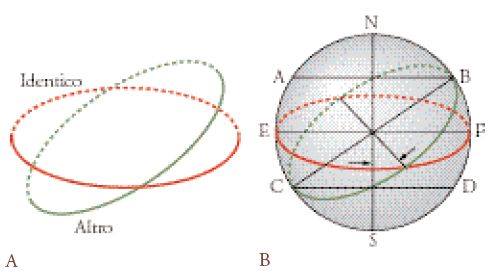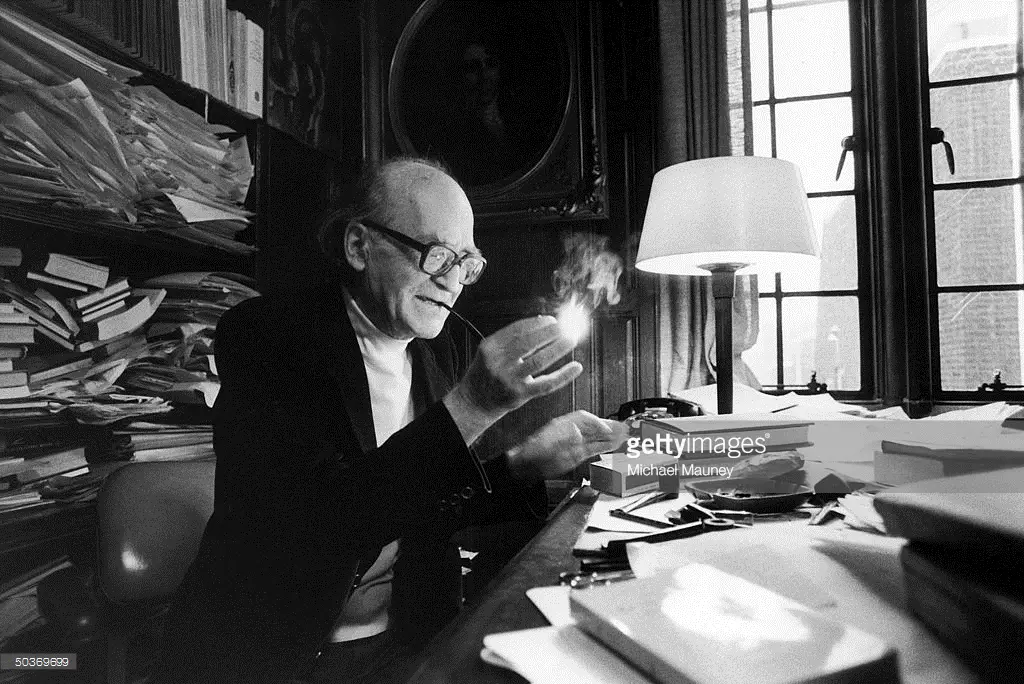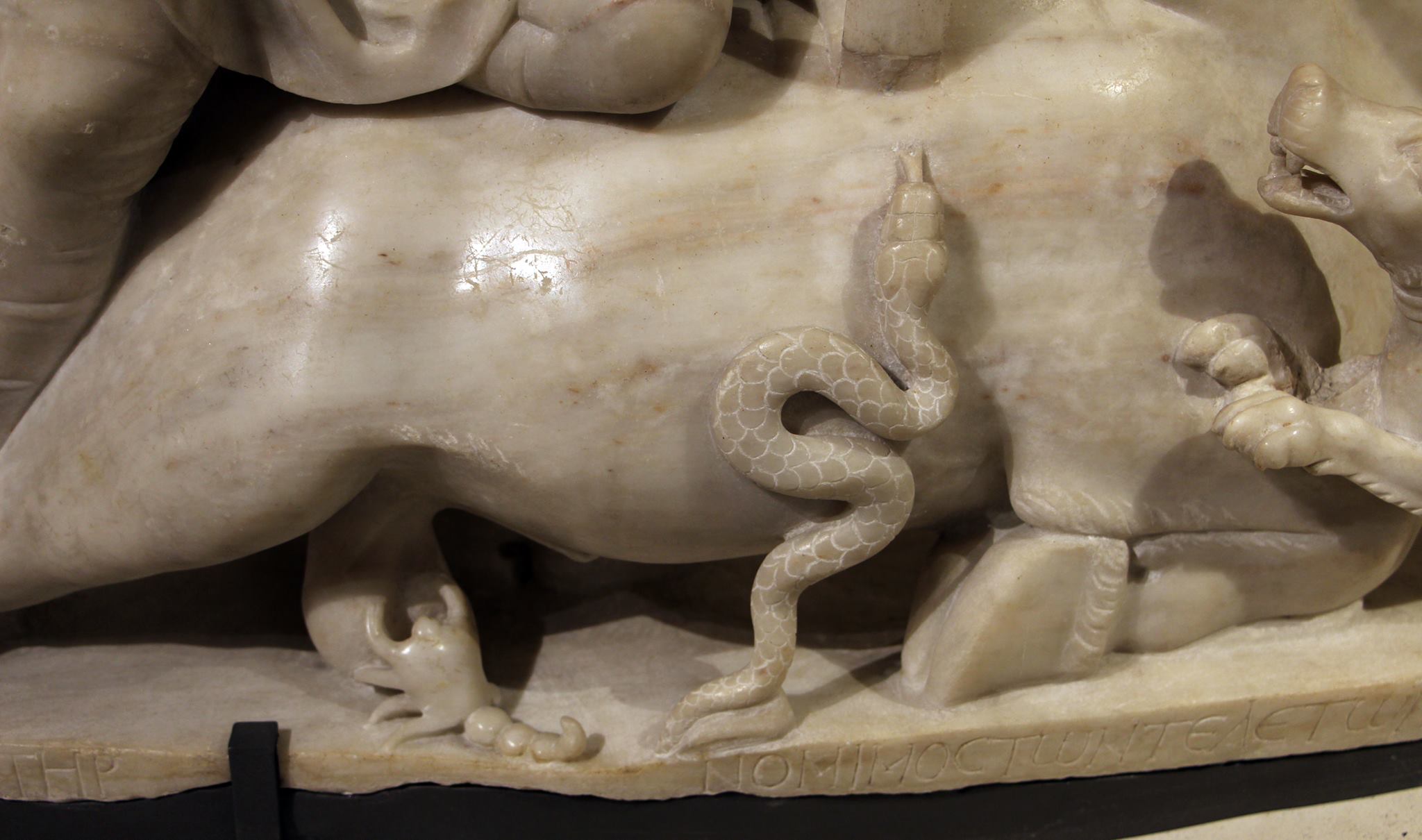di Andrew Casella
cover: William Blake, illustration for Dante Alighieri's Divine Comedy
In the first article of this cycle [cf. Cyclic time and its mythological meaning: the precession of the equinoxes and the tetramorph], we have said that, at regular intervals, due to the precession, some alternations of constellations occur in the four cardinal points of the year. This is the reason why the sacred texts speak of certain "catastrophes" that determine some "submergence" of an old "earth" and the rise of a new one (at least up to a certain time in history). Each age of the world has its "earth", that is its ecliptic plane, delimited by the equinoxes and solstices, which emerges from the "sea", that is, from the demarcation plane of the celestial equator. When the points of the year are determined by other constellations, a new "earth" rises on the horizon, while the old one sinks below sea level.

THEanima mundi and the cross: the Timaeus by Plato
Plato (Timaeus 36 b - c - d) says that the Demiurge composed the soul of the world in the shape of an X (Greek letter who) and then joining together the four vertices at the point opposite to the first intersection, thus forming two concentric circles (so-called circles of the identical and of the different), reciprocally inclined by some degree (X-shaped is also the symbol of the Aztec Tlazolteotl, with the snake and the centipede intertwined, "representation of heaven and earth"; similarly the body of Tiamat is sectioned into two parts by Marduk "how the valves of a mollusk "to form, on one side, the sky, on the other, the land and the sea). To one the Demiurge impressed the movement of the identical (from left to right, that is, counterclockwise), to the other the movement of the different (from right to left, that is, clockwise). This basic structure, this "skeleton" of the soul, we could say, is identical to the graphic scheme of the intersection of the celestial equator with the ecliptic: we can attribute to the first the circle of the identical, while to the second the circle of the different .
Therefore, contrary to what Guénon claims (cf. The symbolism of the cross Postal Code. 6 note 9) do not express concepts of a metaphysical nature intended as "first principles" (it should be borne in mind, moreover, that Plato is describing not the eternal model, but the copy), but empirical elements of a purely cosmological nature (for specifications: Timaeus, and. BUR pp. 204 - 205). Certainly the precise identification of the direction of rotation of the circles is extraordinary, given that, indeed, the earth (and therefore the same line of the equator) turns counterclockwise, while the direction of rotation of the apparent course of the celestial vault (and therefore also of the ecliptic) is hourly. What emerges from the Platonic description of the cosmos is a real armillary sphere, that same sphere whose closest Platonic solid is the regular dodecahedron (symbol of the ether, or fifth element), of which the Demiurge (Timaeus 55c) "He used to decorate the universe with animal figures" (the zodiac).
Leaving aside any hypothesis on the origin of Plato's wisdom (and of the Pythagoreans who certainly transmitted it to him), we observe that traditional data lead to this tripartite division: the sky north of the Tropic of Cancer, which is the "sky" proper, dwells some gods; the inhabited world of the zodiac, between the two tropics, home of the living (the "earth" mentioned above); the sky south of the Tropic of Capricorn, the freshwater Ocean (or Sea of Milk), the kingdom of the dead. Under the "sea", in the southern hemisphere, there is the portion of the ecliptic invisible to us with its pole, which is as if "submerged", given its inclination with respect to the plane of the celestial equator. This is where the Underworld is located. Virgil says (Georgics I, 242 - 243):
“This pole is always high above us; but the other, under our feet, is seen by the black Styx and the underworld Mani ".
The Apocalypse of John
It is surprising how this terminology is preserved in the Apocalypse of John. The mystagogue-astrologer John (Ap. 5, 1 - 5) speaks of those who are unable to open the book sealed with seven seals, "No one, neither in heaven, nor on earth, nor under the earth". No constellation can establish itself permanently to "reign" in the book of heaven, "sealed" with the seven planets: only the Lamb / Aries succeeds. Further on the mystagogue says (Ap. 21, 1): "And I, John, saw a new heaven and a new earth. In fact, the former heaven and earth had disappeared; not even the sea was there anymore". Sky, earth and sea: all three allegories of the celestial vault return. The Apocalypse seems to speak of a renewal that takes place in the celestial vault and of which the Lamb, or equinoctial Aries, is the prince.
The renewal, however, implies a connection between different eras, and so does the Lamb, which however is also the Fish (Ichtys) of the Age of Pisces, declares that (Ap. 21, 6): "Everything is done. I am the Alpha and the Omega, the Beginning and the End". In that moment (Ap. 21, 9 ff.) The mystagogue-astrologer sees the New Jerusalem (the Pure Land) descend from heaven, defined as the "betrothed of the Lamb". Interesting fact is that this city is "quadrangular; its length is the same as its width " (Ap. 21, 16), and has three doors on each side, for a total of twelve (Ap. 21, 13): these are the twelve zodiacal constellations, with the equinoctial and solstitial signs at the corners. The Lamb thus closes the old era, and ideally places himself to reign for ever and ever. The ancient cycles are no longer needed: the time that turned with the sky is stopped in its gears by the Lamb (Ap. 21, 22 - 23):
"But I, John, the temple did not see in the Celestial Jerusalem: the Lord God, the Almighty, together with the Lamb, is his temple. And the city does not need the light of the sun or the moon: the glory of God illuminates it, and the Lamb is its lamp.".
From this brief examination (which deliberately omits other allegories of great interest, such as the seven churches of Asia, symbol of the seven planets [Ap. 2 - 3], or the four horsemen, symbolizing the four seasons [Ap. 6, 1 - 7]) it could be noted that the myth, perhaps for the last time in history, has produced an organic description of celestial events (albeit with an openly eschatological intent) and how it, if one does not have an adequate key to understanding, remains obscure and is susceptible to being distorted.

The foundation of the temple, of the city, of the World
But that's not all, as amply demonstrated by Eliade, the very act of the foundation of buildings, temples, cities, represented, in traditional societies, a repetition of the primordial cosmogony, in a sort of cosmic palingenesis brought back to the earthly plane. And so, every sacred building or space was the mirror of something that resided in the sky. The Babylonian cities had their archetype among the stars: Sippar in the constellation of Cancer; Nineveh in the Ursa Major, Assur in Arthur etc. According to Flavius Josephus, the Temple of Jerusalem made its three parts correspond to the three cosmic regions: the courtyard represented the “sea”, that is, the underworld regions; the holy house represented the earth and the holy of holies the sky; the twelve parts that were on the table were the twelve months of the year: the seven arms of the ten candelabra represented the Decans (ie the zodiacal division of the seven planets into tens). Founding the Temple "Not only the world was built, but also cosmic time" (Cfr. The myth of the eternal return pp. 105 - 106). Everything built on earth imitates the structure of the cosmos in some way. And this is a principle that survived until the Middle Ages with the Builders of Cathedrals, whose concern for astronomical alignments is well known.
It is no coincidence, then, that the periodic destruction of a "world" refers, in the descriptive appearance of natural catastrophes, to a change in the constituted order of the stars. If the sky "collapses", consequently the earth also collapses. All the myths of the world, more or less, retain traces of the ancient astronomical wisdom relating to the upheavals posted by the precession. However, due to forgetfulness and the passing of the ages, they are no longer organic, but mixed together in stories and legends of a heterogeneous spirit. From a certain point forward, says the Dupuis (The Origin of All Cults, Vol II, p. 55): "The thread of astronomical knowledge was lost, and with the leftovers of ancient fables the men they just made up legends, without even understanding the meaning of the fairy tales same ". This is certainly an echo of what Plato himself asserted (Politico): "All these things" Plato is about to discuss the previous epochs, in which the stars turned in the opposite direction "originate from the same condition, and, in addition to these, innumerable others and even more wonderful than these, but due to the amount of time that has passed some of them have been lost, while others have reached us in no particular order and are narrated each separate from another".

The egg and the scorpion
A good example of how the ancient cosmological images ended up being subsequently rearranged and bent to other purposes, without losing their original meaning entirely, comes from Gospel. In Luke 11, 12 it is read: "Which father among you, if his son asks him for an egg, will give him a scorpion?". The image is intuitively connected to an opposition between life and death within the feet familiar: the egg, nourishment, gives life, the scorpion, poisonous, gives death. The meaning is clear, were it not for the impression of a dichotomy so exaggerated as to seem almost ridiculous. In truth, the sentence, as written, has its roots in astrology. In the Mithraic mysteries the egg is a symbol of the primordial unity of the Whole and connects directly to the spherical shape of the zodiac.
As narrated inAvesta (see in this regard Dupuis, The origin of all cults Vol. II p. 12 ff.) The cosmos would have the shape of an egg divided into twelve parts, six of which belong to Ahura Mazda and six to Ahriman. The six parts of Ahriman (incarnation of the winter snake) are the months from the autumn equinox to the spring equinox (autumn-winter). As already explained in the first part [cfr. Cyclic time and its mythological meaning: the precession of the equinoxes and the tetramorph], for about two thousand years il sun rose at the autumn equinox in the constellation of Scorpio (symbol of death also because, according to another aspect, it is located on the exact intersection between the ecliptic and the galaxy): that was the moment in which the darkness seemed to prevail over the light, making the cold and mist fall on the world. The evil principle would be defeated only in spring, with the advent of the relative equinox, which fell under the sign of Taurus. There are many depictions of Mithras sacrificing the Spring Bull, whose testicles (clear vital and generative matrix) are attacked by Scorpio.
The Gospel has done nothing but borrow an ancient astrological concept to place it in the alien context of a narrative with purely spiritual and moralizing purposes. On the other hand, this does not mean that the image is completely empty, since those who wrote the Gospel, in the perfect awareness of what they were doing, intended to preserve its ultimate meaning in order to make it accessible to the generality of the associates, through a apparently childish and gross contrast. If we consider for a moment to which social classes the preaching of Christ was addressed, such an operation of vulgarization appears entirely justified. This intentional "camouflage" is proper to the language of mythos.

Bibliography:
- Charles - Francois Dupuis: The origin of all cults (compendium), Martini 1862
- Giorgio de Santillana - Hertha von Dechend: Hamlet's mill, Adelphi 2003
- Mircea Eliade: The myth of the eternal return, Borla 1975
- Rene Guenon, Symbols of sacred science, Adelphi 1975
- Angelo Tonelli, Eleusis and OrphismFeltrinelli 2015
- Plato, Timaeus, BU 2014


6 comments on “A Science in Tatters: Survival of the Doctrines of Cyclic Time from the Timaeus to the Apocalypse"